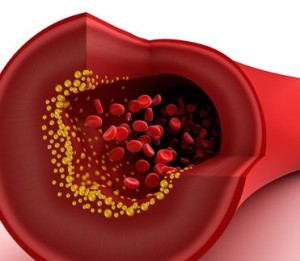 Atherosclerosis is a disease process that entails the buildup of cholesterol, fatty substances, calcium and other substances in the lining of the artery. The term is derived from two Greek words, athero, which means “paste” and sclerosis, which means hardening. This buildup is called “plaque” and can seriously reduce blood flow through the artery. Plaques can also rupture and cause blood clots to form; the clots can break away and travel to another part of the body, or they can enlarge and completely block the artery.
Atherosclerosis is a disease process that entails the buildup of cholesterol, fatty substances, calcium and other substances in the lining of the artery. The term is derived from two Greek words, athero, which means “paste” and sclerosis, which means hardening. This buildup is called “plaque” and can seriously reduce blood flow through the artery. Plaques can also rupture and cause blood clots to form; the clots can break away and travel to another part of the body, or they can enlarge and completely block the artery.
The reduction in circulation caused by atherosclerosis can cause different symptoms depending on where the blockage is. Pain in the legs while walking (claudication) can be the result of restricted blood flow in the leg. Atherosclerosis in the arteries of the heart can cause chest pain (angina) or may lead to a heart attack. If the arteries in the brain are involved symptoms may include sudden numbness or weakness in the arms or legs, difficulty speaking or slurred speech, or drooping facial muscles. These are signs of a transient ischemic attack (TIA) — which, if left untreated — may progress to a stroke. Erectile dysfunction may even be the result of atherosclerosis.
How Healthy are the Arteries?
Various diagnostic tests are used to diagnose atherosclerosis. Doppler ultrasound can be used to measure blood pressure along various points and determine if there is a blockage. Simply comparing the blood pressure in the legs and feet to your normal blood pressure may indicate a blockage. An angiogram can show if the arteries in the heart are narrowed or blocked. Other tests include CT scan, and the magnetic resonance angiogram (MRA). Diagnosis centers around the existence of blockage, but the arteries can be sclerotic and exhibit the beginnings of atherosclerosis before any blockage exists.
Early in the disease, the plaques are forming through a process called engorgement. Cholesterol and other materials involved in making plaque engorge the cells lining the artery. This process is prevented by two substances: Resveratrol and N-acetyl cysteine (NAC).
What About Cholesterol?
The medical approach to preventing atherosclerosis has centered around whether or not blockages are present and in keeping cholesterol down. The main weapon in the doctor’s arsenal is the statin, or cholesterol lowering drug. It turns out that chemically lowering cholesterol is a woefully inadequate approach to preventing atherosclerosis and heart disease.
For one thing, statins do not do that much to prevent heart disease. In one study, that lasted over three years, 2% of the subjects taking a statin had a heart attack and 3% of the subjects in the placebo group had a heart attack. This means that 100 people have to take the drug for three years to prevent a single heart attack. Omega-3 fatty acids perform much better than these drugs for preventing heart attacks.
The other issue about cholesterol lowering drugs is the side effects, which can be life-threatening. The most common side effect is muscle pain. It can make exercise difficult (just what you want in a heart patient–curtailed activity because of pain). The muscle pain can become severe; this is a condition known as rhabdomyolysis. Rhabdomyolysis can lead to liver damage, kidney failure and even death. Other side effects of statins include liver damage, digestive problems and some researchers have linked them to amyotrophic lateral sclerosis (ALS), also known as Lou Gehrig’s disease.
If You Take Statins, Certain Nutrients Help Reduce the Damage
People who are on statins can get muscle pain. Muscle pain is a serious side effect and your doctor should be contacted IMMEDIATELY if you experience it while taking statins. Patients who take these drugs long term tend to lose muscle mass. Many are slightly anemic. There are supplements that you can take to minimize the muscle damage done by statins. These include:
- Coenzyme Q10: Also called CoQ10, it is necessary for energy production in the cell, and it is normally produced by cells. Statins block the production of CoQ10. Studies have linked low CoQ10 levels to heart failure.
- Carnitine: Low carnitine levels are also linked to heart failure.
- Gamma and Delta tocopherol: Vitamin E complex is made up of substances called tocopherols. Gamma and delta tocopherol are part of the vitamin E complex. The one that people are most familiar with is alpha tocopherol; ALPHA TOCOPHEROL IS NOT TO BE TAKEN. It will make matters worse.
- Omega-3 fatty acids: These actually have a better track record for helping to prevent heart attacks than statins do.
How do Statins Work?
Statins work by suppressing an enzyme called HMG CoA reductase, which is responsible for making cholesterol. Blocking that enzyme also interferes with the production of CoQ10, and the loss of CoQ10 may be responsible for the destruction of muscle associated with these drugs.
Fortunately there are natural substances that interfere with the action of HMG CoA reductase, and these substances do not have the associated muscle destruction that the drugs have.
- Red yeast rice should be taken in the evening
- Pantethene also works on the HMG CoA reductase enzyme
- Plant sterols
- Tocotrinols are a part of the vitamin E complex. Vitamin E is made up of four tocopherols (alpha, beta, gamma, delta) and four tocotrienols (alpha, beta, gamma, delta). Tocotrienols can be found in certain vegetable oils, wheat germ, barley, saw palmetto, and certain types of nuts and grains. This variant of vitamin E only occur at very low levels in nature. Take at night, at least 12 hours after taking gamma tocopherol.
- Probiotics have actually been shown to reduce LDL
- Sesame oil can reduce LDL
Cholesterol, HDL, LDL = Inadequate Diagnosis
Most of us believe that if cholesterol is low, our HDL (so called “good” cholesterol) is high and our LDL (so called “bad” cholesterol) is low, we are safe from atherosclerosis and heart disease. It turns out that this way of looking at cholesterol and disease of the heart and arteries is out of date. The likelihood of cholesterol causing plaques is related to the size and number of the particles. Doctors can now order cholesterol panels that include the size and number of cholesterol particles. These new panels give a MUCH better diagnosis and are much better at predicting future problems with the heart and arteries.
The standard cholesterol panel is inadequate and does not accurately predict if a patient is going to have blockage in his or her arteries. When testing for cholesterol you absolutely need to have a panel that includes the size and number of particles.
Statin (cholesterol lowering) medication does nothing to decrease particle size and number. It turns out that omega-3 fatty acids help to reduce the size and number of particles. This is why they outperform statins in reducing the chance for a heart attack.
CRP: Inflammation is More Important Than Cholesterol
While it is common for doctors to test cholesterol, triglycerides, HDL and LDL, it is rare for them to test for CRP. CRP is C-reactive protein and is a measure of inflammation. The two largest risk factors for atherosclerosis are inflammation and the size (and number) of the cholesterol particles. If you want to really know if someone is at risk for atherosclerosis (and the possibility of heart attack or stroke), you need to test the particle size and number when you test for cholesterol and you need to test CRP.
Therapy: Combining Medical and Natural Therapies–AFTER a Proper Diagnosis is Performed
You will need the help of a doctor–you should not treat yourself. This article is just to help you to have an intelligent conversation that leads to effective diagnosis and treatment. Some of the natural substances that may help you include:
Diet: Monounsaturated fatty acids (like in olive oil) reduce the athrogenicity (tendency to form plaques) of cholesterol. The Mediterranean Diet is a good choice. You need to eat lots of fresh produce (full of antioxidants to help lower CRP). Avoid white sugar, white flour and trans fats (all of which increase CRP and inflammation). You should be doing light exercise as well.
Omega-3 fatty acids: Reduce the particle size and number of the cholesterol. Lower the chance of heart attack, and reduce inflammation.
Resveratrol and NAC: Reduce the tendency for plaque to form in the arteries.
Coenzyme Q10: Needs to be replaced if it is being depleted by statin therapy
Carnitine: Needs to be replaced if it is being depleted by statin therapy
D-ribose: Helps to offset muscle wasting
Niacin: Helps lower LDL
Red yeast rice: Works on the same enzyme that the statin medications do, and helps lower cholesterol without the side-effects of statins.
Pantathene: Works on the same enzyme that the statins do, without the side effects
EGCG: Green tea extract, helps lower CRP and reduce inflammation
Gamma tocopherol: Antioxidant, helps protect cells from inflammation
Plant sterols: Can help to lower LDL





